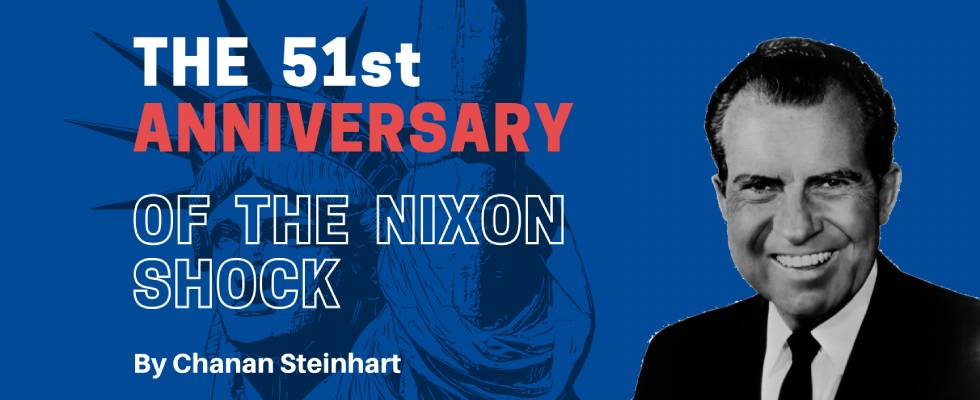The Nixon Shock: Eliminating the Gold Standard
Our monetary supply is, in broad terms the total money supply created and maintained by the Federal Reserve. This money is used to create new money by banks using the fractional reserve mechanism and debt. Our government was held to a minimum of 25% real physical gold post WW2 (40% pre WW2) for printing money as long as the monetary bases were tied to it.
However, this severely limited the government’s funding capacity for wars and entitlement program financing. In response, the US government separated the dollar from the gold backing of its currency in 2 steps. “The Gold Reserve Requirement Elimination Act” was passed in Congress in 1968. Nixon announced in 1971 the end of the dollar-to-gold convertibility obligation, which was established post WWII (“Nixon Shock”).
This led to the dollar becoming a “fiat currency”. Fiat come from Latin and means “let it be”. This implies that money takes its value from state ruling. The state can declare that something of no inherent value, unlike gold, will be considered money. This has caused the monetary system to lose its true meaning, making it now possible to increase the amount of money without any limitations.
The Nixon shock has had an adverse effect on our monetary base
Before the Nixon Shock our monetary basis, which is the total amount in circulation of currency, was around $75 billion. By June 2021, it had grown 80x, to $6 trillion. These and other Federal Reserve printing activities led to the Fed’s record balance sheet of $8.4 Trillion as of October 2021. This is more than 100x than its 1971 volume. The Fed’s Interest Rate has dropped from a peak of 21% (1981) to just above zero (2009), where it has remained much the same since.
The Fed’s accommodative, low-interest rate policy has allowed banks to transform the money supply into more than $85 billion in debt. This represents an increase of $83 trillion in the money stock since 1971. The current century has seen an additional $56 trillion dollars in new money, which is nearly $30 trillion more than before the financial crisis. This is almost four times the GDP growth during these periods.
This new flood of dollars has inherently decreased their value. However, not all sectors have yet been impacted by this massive increase in the money supply or the substantial rise in the prices for goods, services and other commodities.
How the debasement of the dollar was combined with the rise of the Chinese Economy
Around the same time that Nixon introduced the fiat dollars to the globe he established US relations with China. China’s low labor costs and depressed economy made it possible for US businesses to tap into the Chinese economy. Money began to flow eastward. Chinese people welcomed the printing of dollars and were ready to work for them at a salary that was only one-tenth of what equivalent employees in the US would be paid.
Today, the fiat dollar is limited only by the amount of “ink in the Fed’s printers” and by the credit volume that banks are prepared to provide. Since neither of these were in short supply, most of the US industrial base began to move to China, where it was possible to manufacture at a much lower cost. At the end of the 1970s, around 23% of all employers in the US economy operated in the manufacturing sector. This number has decreased to about 8.4% today.
The disappearance of the US industrial sector has had a huge impact on US ‘industrial states’, and it is a historic tragedy where an empire has transferred its entire industrial base to another country, financing its growth to become its largest strategic foe.
Ongoing competition from the Chinese labor market has also seriously harmed wages for individuals and communities working in jobs that could be exported to China. But the migration of jobs did not impact individuals whose jobs could not be exported (physicians, lawyers, and finance professionals). This has created a situation in which the median household income has only increased by around 29% between 1973 and 2018, while GDP has risen more than 3-fold and income increased by 80% among the top 5% of earners.
The Fed-induced money waterfall has therefore been flowing in two directions: One toward China, financing endless imports and taking with it the US industrial sector. The other portion has been flowing toward New York and Silicon Valley, creating an unprecedented rise in asset prices, increasing the price of assets such as stocks and real estate to levels never seen before.And so, while the buying power and the wealth-building of the millennials and the middle class has deteriorated over the last few decades, the ones fortunate enough to own stocks or property have grown their wealth significantly.
A store of wealth that holds purchasing power relies on scarcity. This is what makes gold unique. But with a fiat dollar, it’s possible to create an infinite supply. This is all done according to the whim of the US Federal Reserve, which creates money from thin air, as well as sets the interest rates which fuels the debt money creation machine via loans and banks. This is the one-way path that president Nixon set America on.
2022 marks 51 years since the Nixon Shock. These years saw the US economy experience a rapid rise in US debt, a sharp increase in income inequality, and a decline of 75% in its purchasing power. The US economy’s current trajectory and the Fed’s policy of putting itself in a corner make it reasonable to conclude that “We haven’t seen nothin’ yet.”



